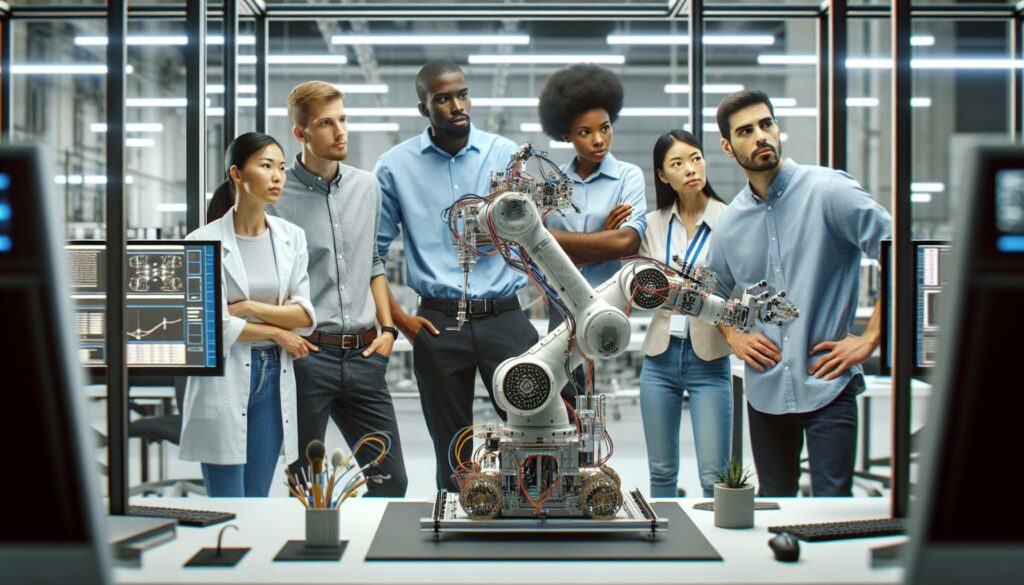In today’s rapidly evolving tech landscape, the concept of polymath robotics is gaining traction. This innovative field merges expertise from various disciplines, creating robots that can adapt and excel in multiple tasks. I find it fascinating how these machines are not just programmed for one specific job but can learn and grow, much like a human polymath. Imagine a robot that can switch from assembling cars to performing delicate surgeries. That’s the potential of polymath robotics. As industries seek efficiency and versatility, this approach could redefine how we think about automation. Join me as I explore the exciting developments in this realm and what they mean for the future of work and technology.
- Definition of Polymath Robotics: Polymath robotics combines expertise from multiple fields, allowing robots to perform various tasks and adapt like human polymaths.
- Advantages of Flexibility: These robots can quickly switch between tasks with minimal reprogramming, leading to reduced downtime and enhanced efficiency in production and service environments.
- Role of AI and Machine Learning: Artificial intelligence and machine learning empower robots to learn from data, make informed decisions, and continuously improve their skills over time.
- Diverse Applications: Polymath robotics finds applications in sectors such as industrial automation, where robots streamline production, and healthcare, where they assist in surgeries and patient care.
- Challenges in Development: The integration faces technical limitations, ethical considerations, and potential job displacement concerns, all of which need to be addressed for wider acceptance.
- Future Trends and Market Potential: Innovations in sensors and collaborative robotics are shaping the future of polymath robotics, with significant market growth expected across various industries, particularly healthcare and manufacturing.
Polymath Robotics
Polymath robotics integrates knowledge from various fields such as engineering, artificial intelligence, and cognitive science. This multidisciplinary approach fosters the development of robots that excel in diverse tasks, mirroring the adaptability of human polymaths. These robots can recalibrate their abilities based on the requirements of each job, be it manufacturing components or assisting in medical procedures.
The core advantage of polymath robotics lies in its flexibility. These versatile machines can switch tasks efficiently without extensive reprogramming, which significantly reduces downtime in production and service environments. For example, a single robot could go from assembling automotive parts to performing precision surgeries, ultimately driving innovation across numerous sectors.
Polymath robotics enhances productivity and efficiency in workplaces. As robots learn and develop new skills over time, they contribute to a more streamlined workflow. The ability to share knowledge across different tasks fosters collaboration between human workers and machines, empowering teams to leverage the unique strengths of each.
Notably, the advancements in machine learning and AI underpin the progress in polymath robotics. As these technologies evolve, robots become capable of not just executing pre-defined actions but also engaging in cognitive tasks that require critical thinking and problem-solving skills.
Key Technologies in Polymath Robotics
Polymath robotics heavily relies on multiple innovative technologies that enhance their capabilities. Two critical components are artificial intelligence integration and advancements in machine learning.
Artificial Intelligence Integration
Artificial intelligence (AI) plays a pivotal role in polymath robotics. AI enables robots to process vast amounts of data in real-time, making informed decisions based on their environments and previous experiences. This capability allows for adaptive learning, which enhances flexibility and operational efficiency. For example, AI-powered robots can analyze production line data and adjust their tasks to optimize workflow. Additionally, AI supports natural language processing, enabling robots to communicate effectively with users and other machines, facilitating seamless human-robot interaction.
Advancements in Machine Learning
Advancements in machine learning (ML) significantly contribute to the development of polymath robotics. ML algorithms allow robots to learn from data patterns, enhancing their ability to perform complex tasks over time. Through reinforcement learning, robots receive feedback on their actions, enabling them to improve continuously. For instance, a robot might refine its assembly techniques by analyzing performance metrics and making data-driven adjustments. These learning capabilities lead to increased automation efficiencies and enable robots to adapt to new challenges autonomously, ensuring they remain valuable assets across various industries.
Applications of Polymath Robotics
Polymath robotics finds extensive applications in diverse sectors, leveraging its versatility and adaptability to improve efficiency and effectiveness.
Industrial Automation
Polymath robotics revolutionizes industrial automation by streamlining production processes. Robots equipped with advanced AI can navigate complex manufacturing environments, handling tasks like assembly, quality control, and material handling. For example, a single robot can adapt to assemble different components on a production line, minimizing the need for specialized machines and reducing costs. This flexibility allows manufacturers to respond swiftly to changing market demands, enhancing competitiveness. Additionally, these robots optimize workflows by analyzing real-time data to predict maintenance needs, thereby reducing downtime and increasing overall productivity.
Healthcare Solutions
Polymath robotics transforms healthcare solutions by integrating cognitive capabilities into surgical procedures and patient care. Robots can assist in precise surgeries, providing consistent accuracy that enhances patient outcomes. For instance, robotic surgical systems allow surgeons to perform complex operations with minimal invasiveness, reducing recovery time. Moreover, robots equipped with AI can monitor patients’ vital signs, manage medication schedules, and provide companionship to those in need. This approach not only increases the level of care but also allows healthcare professionals to focus on more complex tasks, ultimately improving the quality of service in the healthcare sector.
Challenges Facing Polymath Robotics
Polymath robotics faces significant challenges affecting its development and deployment across various sectors. Understanding these obstacles is crucial to maximizing the potential of versatile robotics.
Technical Limitations
Technical limitations hinder the growth of polymath robotics. Robotics hardware often lacks the adaptability needed for different tasks, which affects performance. For instance, sensors may not provide accurate readings in dynamic environments, limiting robots’ ability to perform effectively. Computational power also plays a role; many current robots struggle with processing complex data in real-time, rendering them ineffective for advanced cognitive tasks.
Software constraints impede progress as well. Although advancements in AI and machine learning drive innovation, integrating these technologies into existing systems can be problematic. If a robot requires extensive customization for each new task, the efficiency gains diminish. To streamline operations, improvement in interoperability among systems is essential.
Ethical Considerations
Ethical considerations present a significant challenge in the realm of polymath robotics. Privacy concerns arise as robots gather vast amounts of data for learning and operational optimization. If users’ personal information is improperly handled, it could lead to severe repercussions. Developers need to ensure stringent data protection measures.
Additionally, accountability poses a challenge. As robots take on more complex tasks, determining who is responsible for errors becomes less clear. If a robot malfunctions during a surgery, for example, establishing liability may present legal difficulties. Society must develop frameworks to address these issues to foster trust in polymath robotics.
Finally, job displacement concerns impact public perception. While polymath robots enhance efficiency, they may also threaten jobs across industries. Addressing potential consequences while emphasizing collaboration between humans and robots is essential for wider acceptance and successful integration.
Future Trends in Polymath Robotics
Polymath robotics continues to evolve rapidly, shaped by new innovations and market dynamics. The following trends highlight the future landscape of this exciting field.
Emerging Innovations
Emerging innovations in polymath robotics enhance functionality and efficiency. Advanced sensors enable robots to perceive their surroundings with precision, leading to improved navigation and task execution. For instance, LiDAR technology allows robots to create detailed 3D maps of environments, facilitating navigation in complex spaces.
Collaborative robotics, or cobots, further transform the landscape by working alongside humans in shared environments. These systems prioritize safety and efficiency, adapting to human movements and workflows. Natural language processing advancements allow robots to understand and respond to verbal commands, enhancing user interaction and collaboration.
Decentralized AI contributes to improved responsiveness and adaptability. Instead of relying solely on centralized data, robots can process information locally, leading to real-time decisions based on immediate conditions. This innovation significantly impacts industries like manufacturing and logistics, where timely execution is crucial.
Market Predictions
Market predictions indicate robust growth for polymath robotics across various sectors. According to a report by Markets and Markets, the global robotic process automation market is projected to reach $25.56 billion by 2027, growing at a CAGR of 32.8% from 2022. This growth underscores the increasing demand for flexible, multi-functional robotic solutions.
Healthcare specifically offers substantial opportunities for polymath robotics. The global medical robotics market is expected to hit $20.98 billion by 2026, driven by innovations in surgery assistance and patient care. As robots take on more complex roles in healthcare, their utility will expand, providing efficient solutions for care delivery and improving patient outcomes.
Manufacturing will also see significant advancements as companies invest in automation. The Industry 4.0 movement emphasizes smart factories, leveraging robotics for increased efficiency and reduced operational costs. Manufacturers that embrace polymath robotics can achieve greater competitiveness and agility in responding to market changes.
Polymath robotics represents a thrilling frontier in technology that promises to reshape industries and redefine our relationship with machines. The ability of these robots to adapt and learn opens up endless possibilities for efficiency and productivity.
As I look to the future I see a world where robots seamlessly integrate into various sectors enhancing human capabilities rather than replacing them. The collaboration between AI advancements and multidisciplinary approaches will drive innovation and create opportunities we can only begin to imagine.
Embracing this evolution is essential for businesses aiming to stay competitive in an ever-changing landscape. The journey of polymath robotics is just beginning and it’s an exciting time to be part of this transformative wave.

